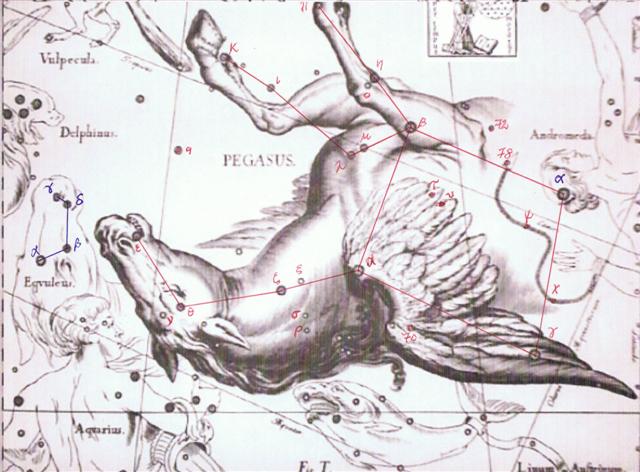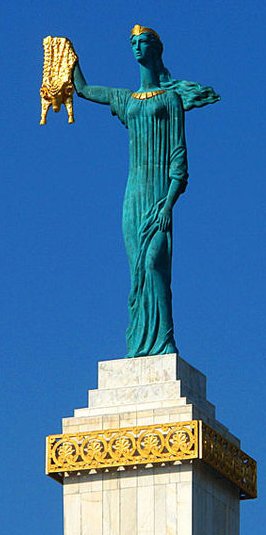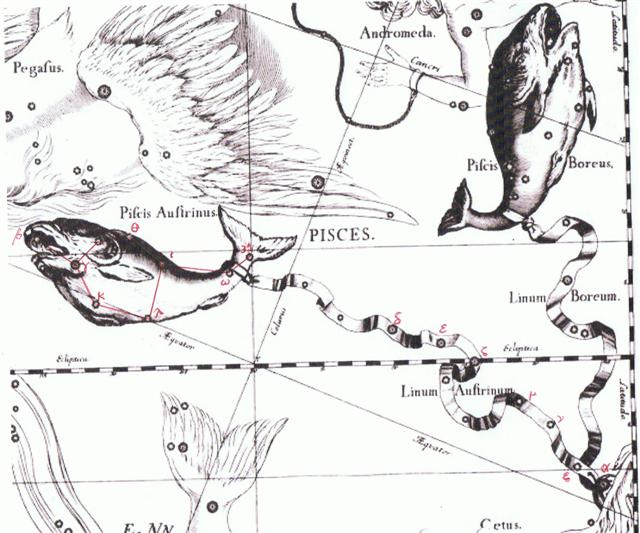Since the ancient time when the Argonauts fetched the Golden Fleece - at a time of the year which probably corresponded to the northern spring equinox - the position of Argo Navis in the sky would have drifted forward due to the precession.
"The Argonauts, with the Golden Fleece on board, had to pass the Symplegades, the clashing rocks. Once a ship with its crew came through unharmed - so the 'blessed ones' (makaroi) had decided long ago - the Symplegades would stay fixed, and be clashing rocks no longer. After that 'accepting the novel laws of the fixed earth', they should 'offer an easy passage to all ships, once thay had learnt defeat'. This is only one station on the long 'opening travel' of the Argonauts transporting the Golden Fleece (of a ram), undertaken in all probability to introduce the Age of Aries, but it demonstrates best the relevant point, namely, 'the novel laws'." (Hamlet's Mill) When Aldebaran was at 0h then the Front of the Head of Ku (Sheratan in the Ram) had been 41 days earlier in day 80 - (68 - 27) = 39 (FEBRUARY 8). Or we could count from the beginning of the previous JANUARY 1 and regard FEBRUARY 8 as day 365 + 39 = 404 = *324 days from MARCH 21. Then the Head of Ku turned around and 3 days later, in FEBRUARY 11, the Back of his head rose with the Sun. To turn around was a remarkable event and probably it was regarded as a Sign indicating how a cardinal point had been passed.
Likewise should there have been a point of turning around at the JUNE solstice: ... 'To sleep within the Goddess's womb was to die and to come to life anew' ...
But the cardinal points themselves could have been hidden from view by for instance an extended net or a piece of cloth (or of fur, such as a fleece):
... Some think îka was a euphemism for a human sacrifice to be offered to the gods (and also perhaps cannibalized upon). I don't think so. Or rather: If it was so, then it was not the original explanation, but rather a secondary application of the primary îka concept. Instead I believe in ancient times fishes alluded to the heavenly bodies. After all, the sky is blue like the ocean and therefore, presumably, there are fishes in the sky. The principal word for 'fish' in most Dravidian languages is min, which has an ancient homophone meaning 'star', both probably derivatives of the root min 'to glitter'. Fish are actually unable to close their eyes, and the fact that 'when the fish sleeps it does not close its eyes' was noticed by ancient Indians. The dot-in-a-circle similar to that occuring among the trefoils of the Harappan priest-king's robe is identical with the eye of the many small hare- and fish-shaped amulets discovered on the lower levels of Harappa. (Asko Parpola, The Sky Garment.) There is a dark blotch looking like the head and long ears of a hare (or rabbit) in the moon, which can account for the hare-shaped amulets, and then the next step to stars as fishes is infinitesimal. Moon can be seen also during the day, but the stars only during the night - by the theory of correspondences equal to winter and the dark sea. On Easter Island, with a free view to the horizon in all directions, the heavenly bodies ascend in the east as if drawn up like glittering fishes from the ocean ... If Atea was changing her sex to become a male at Ga4-14 (alluding to 414 = 14 * 29½ + 1), then there ought to be an opposite change later in the year (to restore the cosmic order). JUNE 26 (177) + 366 / 2 = DECEMBER 26 (360) when Matar (η at the right front leg of Pegasus) rose with the Sun:  ... Now the deluge was caused by the male waters from the sky meeting the female waters which issued forth from the ground ... We can now guess why Maui was born in a topknot - it was because his mother Taranga had changed her sex earlier in the year to become a warrior: ... 'From the time I was in your womb,' Maui went on, 'I have known the names of these children of yours. Listen,' he said as he pointed to his brothers in turn. 'You are Maui mua, you are Maui roto, you are Maui taha, and you are Maui pae. And as for me, I am Maui potiki, Maui-the-last-born. And here I am.' When he had finished, Taranga had to wipe her eyes because there were tears in them, and she said: 'You are indeed my lastborn son. You are the child of my old age. When I had you, no one knew, and what you have been saying is the truth. Well, as you were formed out of my topknot you can be Maui tikitiki a Taranga.' So that became his name, meaning Maui-formed-in-the-topknot-of-Taranga. And this is very strange, because women in those days did not have topknots. The topknot was the most sacred part of a person, and only men had them ... The precise locations in time-space were not permanent. New 'laws' - far interspaced - would change the details. JUNE 26 (177) together with day 360 (DECEMBER 26) could for instance have changed to a structure with JUNE 30 (181) together with day 364 (DECEMBER 30):
Ga4-18, where the Full Moon was at the Mouth of the Fish in Pisces (β), had nuku at left and a tail (vaero) at right:
It should here be remembered that Gregory XIII changed the cosmic laws: ... When Julius Caesar established his calendar in 45 BC he set March 25 as the spring equinox. Since a Julian year (365.25 days) is slightly longer than an actual year the calendar drifted with respect to the equinox, such that the equinox was occurring on about 21 March in AD 300 and by AD 1500 it had reached 11 March. This drift induced Pope Gregory XIII to create a modern Gregorian calendar. The Pope wanted to restore the edicts concerning the date of Easter of the Council of Nicaea of AD 325. (Incidentally, the date of Easter itself is fixed by an approximation of lunar cycles used in the Hebraic calendar, but according to the historian Bede the English name 'Easter' comes from a pagan celebration by the Germanic tribes of the vernal - spring - equinox.) So the shift in the date of the equinox that occurred between the 4th and the 16th centuries was annulled with the Gregorian calendar, but nothing was done for the first four centuries of the Julian calendar. The days of 29 February of the years AD 100, AD 200, AD 300, and the day created by the irregular application of leap years between the assassination of Caesar and the decree of Augustus re-arranging the calendar in AD 8, remained in effect. This moved the equinox four days earlier than in Caesar's time ... ... Gregory dropped 10 days to bring the calendar back into synchronisation with the seasons. Accordingly, when the new calendar was put in use, the error accumulated in the 13 centuries since the Council of Nicaea was corrected by a deletion of ten days. The Julian calendar day Thursday, 4 October 1582 was followed by the first day of the Gregorian calendar, Friday, 15 October 1582 (the cycle of weekdays was not affected) ... From 45 BC to AD 325 there were 370 years and 370 / 71 = ca 5.2 days of precession. March 25 - 5 = March 20 (not March 21). ... we must take language seriously. Imprecise language discloses the lack of precision of thought. We have learned to take the language of Archimedes or Eudoxus seriously, simply because it can translate directly into modern forms of thought. This should extend to forms of thought utterly different from ours in appearance. Take that great endeavor on the hieroglyphic language, embodied in the imposing Egyptian dictionary of Erman-Grapow. For our simple word 'heaven' it shows thirty-seven terms whose nuances are left to the translator and used according to his lights ... The number of glyphs on the C tablet is 740, which could represent 20 * 37 days or twice the time length of the orbit of Uranus:
... In the Olympian creation myth, as Hesiod tells it in the Theogony, Uranus came every night to cover the earth and mate with Gaia, but he hated the children she bore him. Hesiod named their first six sons and six daughters the Titans, the three one-hundred-armed giants the Hekatonkheires, and the one-eyed giants the Cyclopes. Uranus imprisoned Gaia's youngest children in Tartarus, deep within Earth, where they caused pain to Gaia. She shaped a great flint-bladed sickle and asked her sons to castrate Uranus. Only Cronus, youngest and most ambitious of the Titans, was willing: he ambushed his father and castrated him, casting the severed testicles into the sea. For this fearful deed, Uranus called his sons Titanes Theoi, or 'Straining Gods' ...
|
||||||||||||||||||||||||||||||||||||||||||||||||||||||||||||||||||||||||||||||||||||||||||||||||||||||||||||||||||||||||||||||||||||||||||||||||||||||||||||||||||||||||||||||||||||||||||||||||||||||||||||||||||||||||||||||||||||||||||||||||||||||||||||||||||||||



















